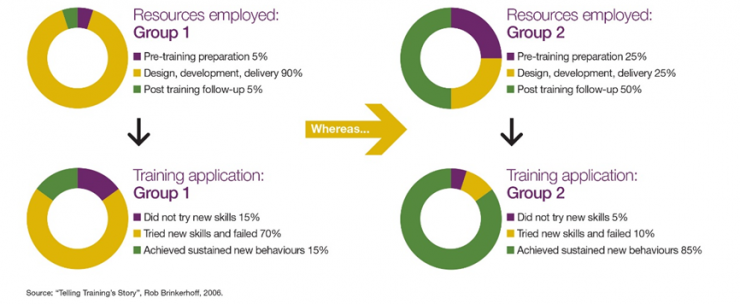How to get beyond “tick box” training to achieve meaningful results


Derek Robertson , CEO
(Chartered FCIPD, MCMI, MInstLM, NLP Practitioner and Coach)
8 min read
Training budgets are tight. They’ll always be tight. Add in off-the-job costs and your true investment mushrooms. It’s vital then, to set your sights beyond “tick box” to achieve consistently meaningful training.
As a senior person in your organisation, perhaps heading up HR or as MD, squeezing every penny of value from your training investment will be up there for you. If it’s not, stop reading and go back to whatever displacement activity soothes your job worries. I hear TikTok’s good for that.
Now you’re still with me, let’s confirm why meaningful training is so important and then consider six action areas to help you.
What is meaningful training, and why does it matter?
Any conversation that asks, “Have you done your training?” or “Have you been through your management development?” reeks of “tick box” training. It suggests that success is about completing the input.Being satisfied with “tick box” instead of meaningful training is like wanting apples from your garden, planting a seedling and leaving it to its own devices. It’s delusional to you, your teams and your business ambitions.
Conversations that start with, “What are you applying from your learning?” or “I see your chairing of yesterday’s meeting went really well” speak to meaningful training.
In meaningful training you’re focused on measurable results, bang for your buck, ROI (I hate TLA’s!) and achieving your strategic objectives.
This matters because it:
- Determines the types of performance for your business
- Makes it easier to get future training budgets
- Transforms you into a boardroom hero.

How to achieve meaningful training
1 Get all your brains in gear
Remember the tick box language above? You must ban it. Catch people in the act and redirect their mindset. Focus them on the language of learning’s value, workplace actions and showing results.
2 Great expectations
Set expectations for everyone involved. That includes your procurement people, trainers, training participants and their line managers. These expectations include:
- Active participation in the training
- Specific action plans following training
- Immediate workplace actions
- Support, feedback and challenge from line managers
- Showing meaningful results from the training.
Go get a rotten smelly fish from your local store. Slap anyone who says, “I’m happy if my guys come back from training with one thing.”1
3 Remember you're training adults
You don’t need theorists like Malcolm Knowles2 to know that adults need to, use their experience, see immediate application and be truly involved in their learning.
If you have ‘pour and snore’ training delivered by a ‘talking head’ as your input, you can say, goodbye to meaningful training as your output.
4 Forget the training event
The ‘once and done’ mantra has its place in many business fields. Not for training. Only the tick box mentality relies solely on the training session – be it in person, live Zoom or e-learning. It’s like planting that apple tree seedling, ticking it off your list believing you’ll be making your own cider in late summer.
Rob Brinkerhoff3 shows us that meaningful training likelihood skyrockets when you allocate resources as follows:

It’s the approach the Robertson Training Team swear by with our clients.
5 Challenge your training deliverers
Outsource or insource makes no difference, your training must be meaningful.
Back to apples. Would you invest £100 of your own money to have a landscaper plant an apple tree seedling in your garden and leave?
Result: No apples (perhaps maybe one or two if you’re lucky)
Or, would it be better for you to invest £120 of your own money to have the landscaper prepare your ground, plant the apple tree seedling and tend to it while it takes root.
Result: A plentiful supply of apples year on year?
You’re right. It’s a no brainer. Don’t settle for just a tick in the box to report that you planted the tree and left the results to random chance. Instead, demand a process to enable adult trees to bear (training) fruit. Fruit that makes your precious investment meaningful.
6 Close the loop
You know that you’ve achieved meaningful training when you have measurable results to celebrate. How many apples is easier to measure than say leadership development, but you get the analogy.
Continue with your robust and demanding processes after the training to harvest measurable results. Sometimes it could be ROI. More likely it’s ROE (return on expectation). That is, the expectation you intended at the start of your process.
I know you won’t have pitched training to your stakeholders as, “We’ll do this so I can come back to you £50,000 later and say, we ticked the box”. Closing the loop is about returning to show your meaningful, measurable results. That way you will be a boardroom hero.
A facilities management client of ours wanted to tick off a reactive need to ‘do diversity awareness’. Our post training data showed lots of meaningful application examples in the participants’ teams. They included calling out inappropriate language, creating and leading their own awareness sessions plus measurable improvements to team consultation and involvement.
If this blog challenged you: good. That was my intention. The team and I at Robertson Training want you to succeed with meaningful results from all your business skills, leadership and team development.This may be the start of a new meaningful training world for you, your team and your business.
If it didn’t challenge you, I’d love to feature your achieving consistently meaningful training results in an interview about great training practice.
Check out our case study on tick box training
Sources and notes
- Please don’t actually slap people with wet fish. I was using it as a metaphorical device.
- Knowles Theory of andragogy: https://www.instructionaldesign.org/theories/andragogy/
- ‘Telling training’s story’ Rob Brinkerhoff, 2006

